Last Wednesday, I woke up with a bit of a throat. Nothing big, just one of those fizzy, back of the throat tickles that could be allergies or could be the beginning of a cold. The kind of sore throat that makes you crave chicken noodle soup, or a vegetarian equivalent. Fortunately, I had some homemade, Saturday morning after the Market vegetable broth in the freezer.  That could stand in for chicken stock, but what about the noodles? That’s when I hit upon won tons. I’d had dumplings on the brain since I made pot stickers for Chinese New Year. Some yummy won tons in a slightly Asian-ised vegetable broth with a few fresh veggies and lots of tummy-settling ginger would satisfy my desire for throat-and-soul-soothing, brothy soup while constituting a sufficiently hearty meal for my hardworking sweetie.
That could stand in for chicken stock, but what about the noodles? That’s when I hit upon won tons. I’d had dumplings on the brain since I made pot stickers for Chinese New Year. Some yummy won tons in a slightly Asian-ised vegetable broth with a few fresh veggies and lots of tummy-settling ginger would satisfy my desire for throat-and-soul-soothing, brothy soup while constituting a sufficiently hearty meal for my hardworking sweetie.
What, you might ask, qualifies me — an ageing white chick from the Deep South of the US living in New Zealand — to improvise Chinese soup? Well, first of all, I had a poster of Mao Zedong tacked to the ceiling over my bed throughout my teenage years. Why, you ask? Probably for the same reason I wore a dog collar all through High School: to annoy my parents, to get attention without actually DOING anything. My rebellion was pretty wimpy. I also own and have actually read The Military Writings of Mao Tse-Tung and Sun Tzu’s The Art of War, relics of my Ph.D. studies.
Second, I took — and survived — two semesters of Chinese History at the University of Georgia. The professor, Dr. Thomas Ganschow, was recognised as one of the very best teachers at the University of Georgia. He was also renowned for his marathon exams, the undergraduate equivalent of the Mandarin Eight-Legged Essays, for which the questions were sort of : write down all human knowledge. Be specific and include dates. Tom was the main reason I finally realised resistance was futile: I would be an historian. He also launched me on my lifelong quest to understand how other cultures work. My Dad continued to hold out for accounting in the hope that I might, someday, be gainfully employed.
Tom and his lovely Taiwanese bride, Lisa, became good family friends over the years. Lisa was the manager of the Athens Area Community Food Bank, where my mother volunteered as a board member and Thank You Note writer. Really, everyone who donated food or money to the Food Bank got a handwritten Thank You from my Mum. The Thank You Note is a lost art, leaving the world a less gracious place. Lisa is also a fabulous cook. Before my first wedding, some of Mum’s friends threw me a Recipe Shower. Lisa gave me her recipe for Chinese Egg Rolls. I cherished it. I still have it. In fact, I think I will dig it out and work on a vegetarian version. Watch this space!
I have been to China twice, both times for work. Because I was not allowed to take any technology — no smart phone, no laptop — into China, I actually got out and did things instead of staying in my hotel catching up on work, which was too often what I ended up doing on work trips. On my first trip I visited the Great Wall and the Forbidden City and met Helmut Kohl, despite my falling victim to fairly paralysing food poisoning. I was at the Great Wall on the hottest day in human history. It was 114F/45C. Honestly! I was the only person insane enough to be up there in such weather. It was so hot my hair turned bright orange! Between sweat and food poisoning, I lost about 5 kilos on that trip!
On my second trip, I had the unique “pleasure” of being stuck in a parked aircraft on the ground while Beijing had a rare, early November blizzard. The snow plows were still in dry dock. But the snow did, temporarily, sweep away Beijing’s legendary air pollution, so I woke up the next morning to the truly once-in-a-lifetime spectacle of Beijing under clear, sparkling blue skies!
My adopted Elder Sister, Kongdan Oh Hassig, a Korean China expert and linguistic whiz kid, gave me a Chinese name for my 50th birthday. Zhen Kailian means “triumph” and “lotus flower.”  I love that. Triumph means so much to me, given my lifelong war of attrition with depression and anxiety. And the lotus flower symbolises, according to buddhist.org, “rising and blooming above the murk to achieve enlightenment.” My next tattoo will be a lotus flower.
I love that. Triumph means so much to me, given my lifelong war of attrition with depression and anxiety. And the lotus flower symbolises, according to buddhist.org, “rising and blooming above the murk to achieve enlightenment.” My next tattoo will be a lotus flower.
Note to Katy: my reputation is in your hands. If Zhen Kailian actually means “Old Lady with Baggy Knickers,” it’s on you!
Katy and I traveled together a lot. She is fearless and up for just about anything. Sadly, we have never been to China together, although we did drink civet poop coffee in Bali.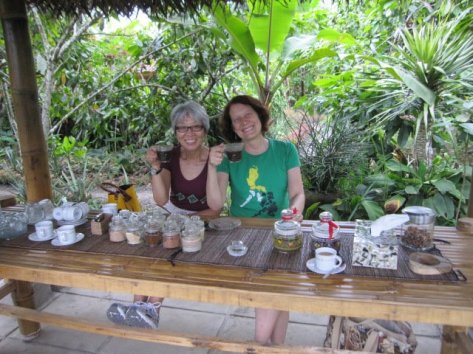
Finally, some of the most interesting foods I find at the Riverbank Farmers’ Market are Asian: the beautiful Asian greens, giant daikons, strange and wonderful bitter melons, snake beans, and snow peas. Then there is the Thai herb lady who sells all kinds of Asian flavour makers: Thai basil, lemongrass, galangal, and turmeric root. And the Chinese gentleman with his handmade tofu and fresh Chinese noodles.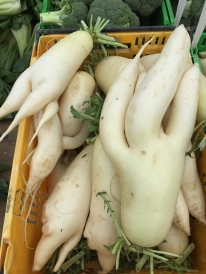
And last but not least, the “I Love Dumplings” ladies serve up the most delicious vegan potstickers ever. My last stop every Saturday morning is at their stall, where I buy a dozen dumplings for $5. Sometimes they are so busy, I have to wait. And I do. Because the dumplings are just that good. Simon and I arm-wrestle for them for the rest of the day. I could get 25 dumplings for $10. Every week I consider this option, only to conclude that there can be too much of a good thing. But I don’t believe that. Some Saturday in the future, I’ll probably give in to temptation. But not this week. Their dumplings provided the inspiration for my won tons.
So, armed with these questionable qualifications, I set out to invent a delicious and healing won ton soup that would be 1) edible, 2) not insulting to Chinese cuisine, and 3) worthy of the name Zhen Kailian. What I came up with was pretty darned tasty, if I may say so myself.
Zhen Kailian Won Ton Soup
Ingredients: For the Won Tons
200g / 7 oz extra firm tofu
1/2 small napa cabbage, finely chopped, (about 1 lb / 450g)
1 TBSP grated fresh ginger
3 shallots, finely chopped
2 cloves garlic, minced or put through a press
1/2 0z / 15 g dried shitake mushrooms, soaked in 1 cup / 700 ml) boiling water
2 TBSP / 3 ml white sesame seeds
2 TBSP / 3ml soy sauce
24 fresh wonton or gyoza wrappers
1 egg white, beaten to soft peak stage (optional)
For the Broth:
6 cups / 1 1/2 liters vegetable broth, preferably homemade, definitely low-salt
2 pieces dried kombu (optional, but nice)
a thumb-sized bulb of fresh ginger
2 cloves garlic, peeled and cut in half
leftover mushroom soaking water
2 glugs (about 1/4c / 60ml) low-sodium soy sauce
1 glug (about a TBSP) toasted sesame oil
For the Soup:
Broth
1 large carrot, thinly sliced on the diagonal
1 stalk celery, also thinly sliced on the diagonal
a handful of greens, I used thin ribbons of kale, but baby bok choy would be nice, too
Steamed Jasmine Rice, optional
thinly sliced scallions for garnish
Let’s Make Soup:
Set the broth on to simmer at very low heat with the kombu, ginger, garlic and mushroom water. Give it at least 30 mins, but an hour plus would be OK, too.
To make the wonton filling:
- Toss the finely grated cabbage with some salt (a big pinch) in a colander and let sit for an hour or so to drain. If you are careful with the salt, you shouldn’t need to rinse the cabbage, but taste it just in case, to ensure that it isn’t too salty.

- Squeeze out as much liquid from the cabbage as you can, then roll it up in a tea towel and squeeze out even more. The cabbage should be really dry.

- Drain and finely chop the mushrooms.
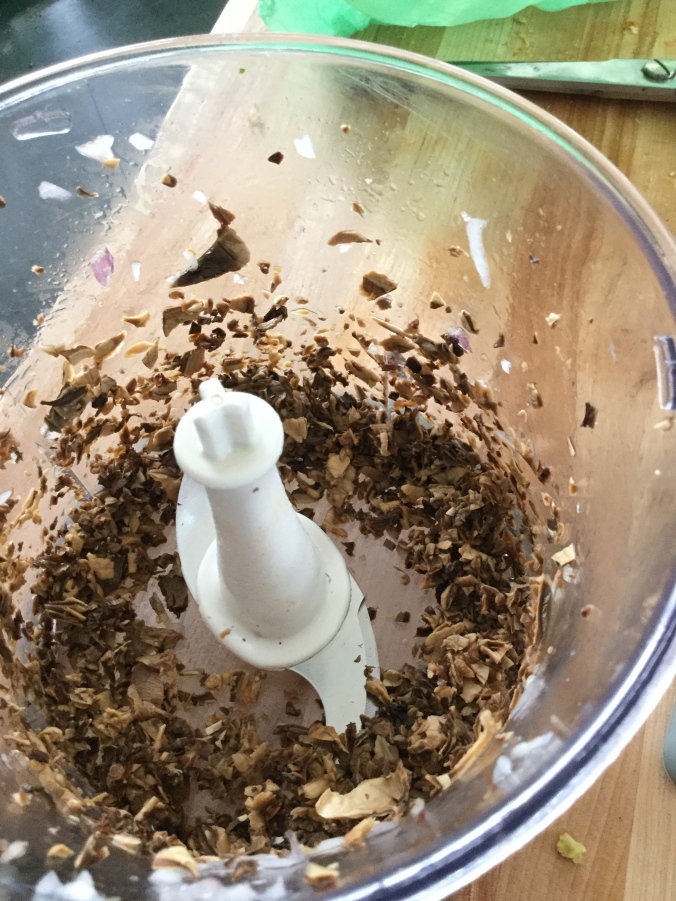
- Chop the scallions and garlic and grate the ginger.
- Either dice the tofu (I used sesame marinated tofu) or chop it in a food processor.

- Heat about a tablespoon of neutral oil, preferably peanut oil, in a medium skillet and sauté the shallots until they are getting brown and crispy.
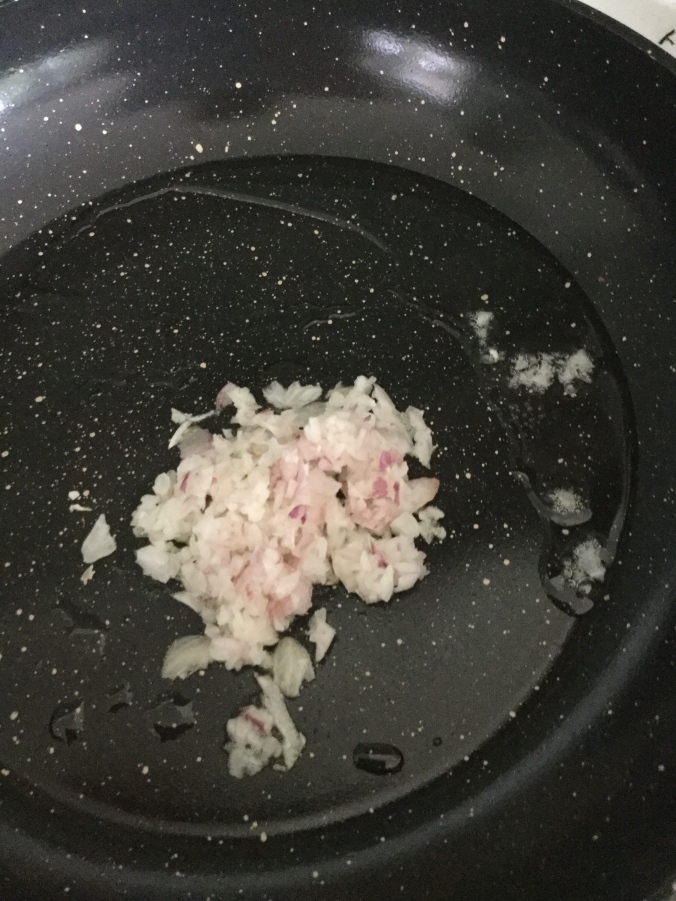
- Add the garlic, ginger, and chopped mushrooms and sauté for a couple of minutes.
- Then, add the diced/chopped tofu and sauté until it starts to get brown and crispy.
- Add the cabbage and sauté until it is wilted and dry.
- Take the filling off the heat and add the soy sauce and sesame seeds.
- When the filling is cool, fold in the beaten egg white. If you want your won tons to be vegan, you can leave this out. The egg white sort of puffs up when the won tons cook, so they are fluffy, but this is a purely aesthetic thing. If you don’t mind dumpy dumplings, leave out the eggs!
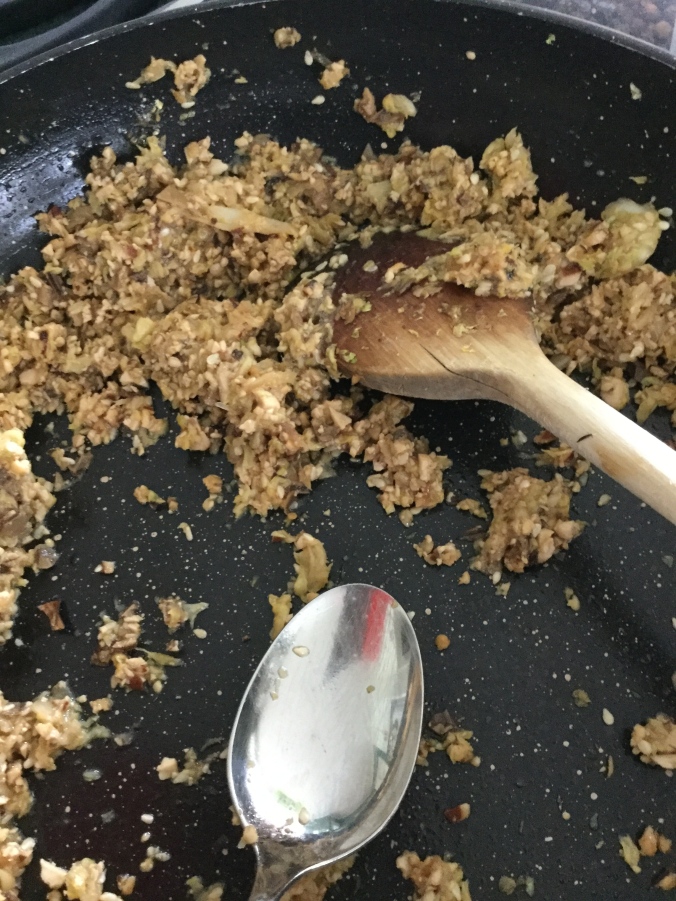
- Lay out your dumpling wrappers. Put a generous tablespoon of filling on each one, then brush the edges with water to seal them.
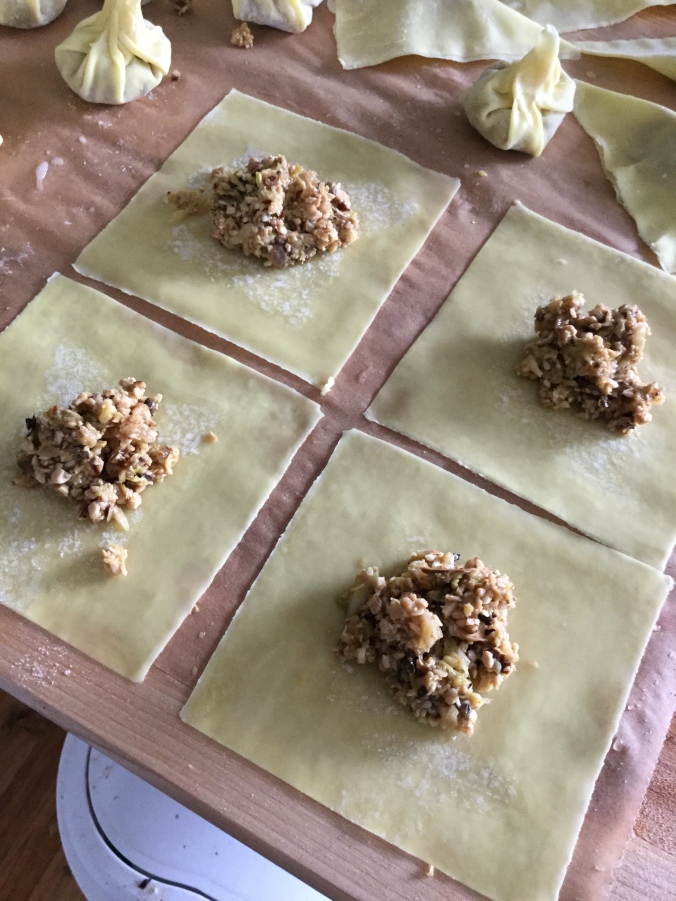
- You have a choice of dumpling shapes: if you have square wrappers, you can make flat triangles (just fold them over once and seal), “nurses caps” (pull the two tips of the triangle on the folded edge together and seal, or “purses” (dampen all four sides, bring them together and twist to seal). If you have round wrappers and you are a showoff, you can make pleated dumplings. I didn’t have round wrappers, so I couldn’t make those. Which shape you chose is just a matter of personal preference. Simon and I were divided. He preferred the purses. I thought the bunchy part was a bit too stodgy. I preferred the nurses caps. The flat triangles turned out to be a bit tricky to eat.
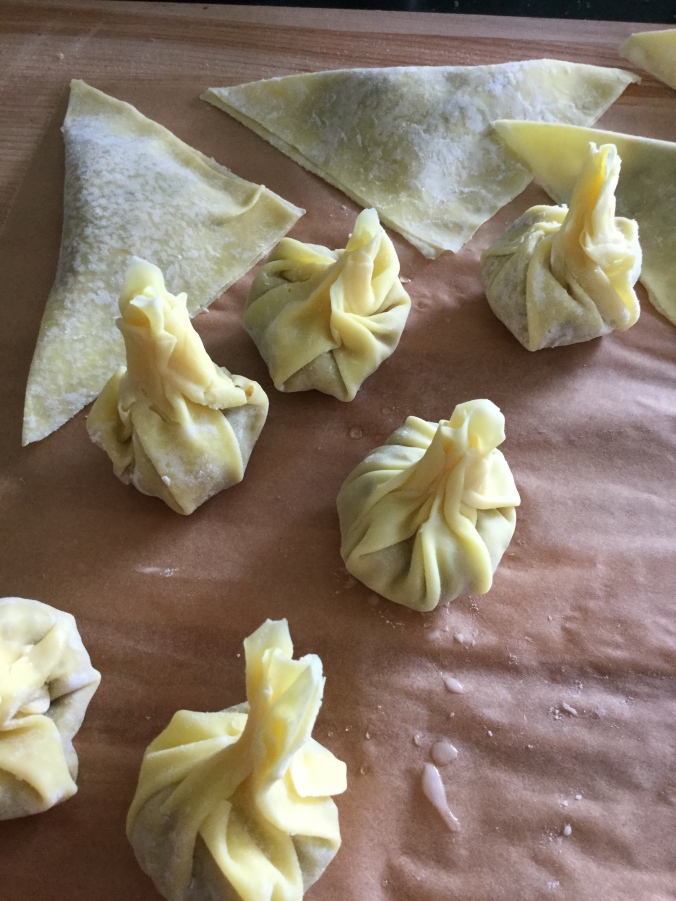
Now, put it all together!
- Bring your yummy broth to a simmer and add the sliced carrots, celery, greens. Let them simmer for a couple of minutes, add the soy sauce and sesame oil, then
- Add your won tons — yes, you are going to cook them right in the broth. Let them simmer for 2-3 minutes.

- If this is dinner, you can bulk things up a bit by putting a scoop of jasmine rice in the bowl. This also adds a little textural interest.
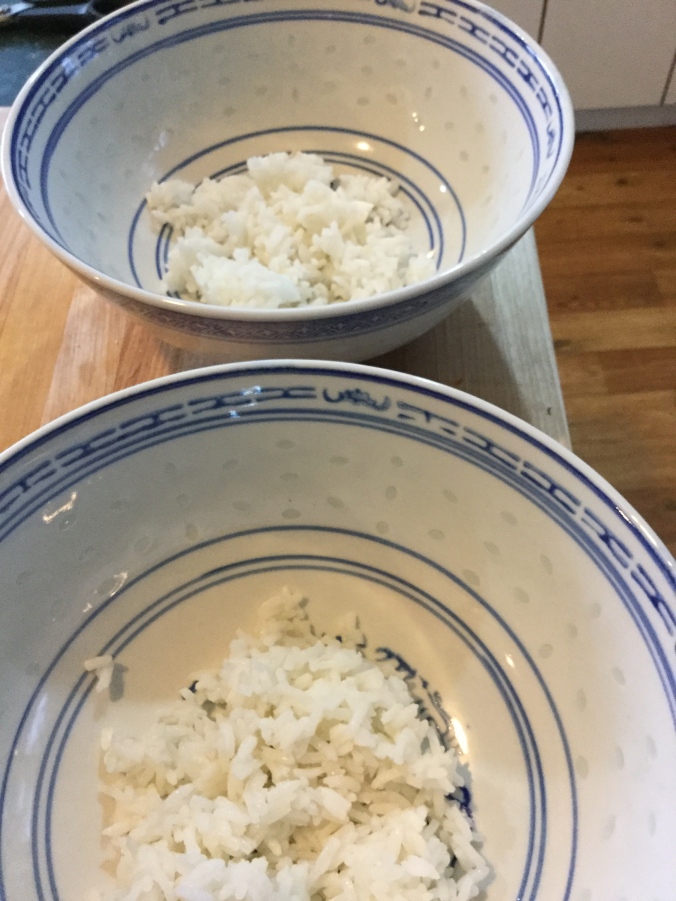
- Lay the cooked wontons on the rice, then ladle over the broth and vegetables.

- You can garnish the whole thing with some thinly-sliced scallions and/or bean sprouts.












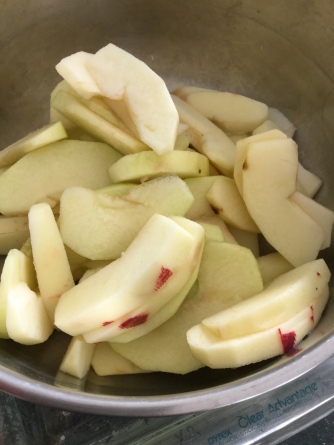








 Now they are a national franchise and they have wandered from their Memphis roots. RH&B now offers five different sauces, <gasp> Barbecue Brisket, and <double gasp> pulled chicken. The original, homey, hole-in-the-wall location in Arlington has, sadly, closed.
Now they are a national franchise and they have wandered from their Memphis roots. RH&B now offers five different sauces, <gasp> Barbecue Brisket, and <double gasp> pulled chicken. The original, homey, hole-in-the-wall location in Arlington has, sadly, closed.

 I used Penzy’s Ozark Blend, which is very black peppery. Think Col. Sanders secret herbs and spices. If you don’t live in the United States and can’t get Penzy’s excellent spice blends, use whatever spices you like. And next time you are in the US, find a Penzy’s store and stock up! You can mail order, too.
I used Penzy’s Ozark Blend, which is very black peppery. Think Col. Sanders secret herbs and spices. If you don’t live in the United States and can’t get Penzy’s excellent spice blends, use whatever spices you like. And next time you are in the US, find a Penzy’s store and stock up! You can mail order, too.



















 When the hundred-year blizzard hit DC in 1996, I was attending a conference at Wilton Park in the UK. I came home to find all my upstairs window wells an inch deep in water. I hated that. I hate that people put salt on the sidewalk that irritates my dogs’ feet so I have to wash their paws whenever we come in from a walk. I hate people who think that just because there is snow on the ground, they don’t have to pick up after their dogs, as though the poop will disappear with the spring thaw. I hate leaky snow boots. Snow ice cream? Yuck. Snowmen? Depressing when they melt. And they always melt. I, ladies and gentlemen, am a snow Scrooge.
When the hundred-year blizzard hit DC in 1996, I was attending a conference at Wilton Park in the UK. I came home to find all my upstairs window wells an inch deep in water. I hated that. I hate that people put salt on the sidewalk that irritates my dogs’ feet so I have to wash their paws whenever we come in from a walk. I hate people who think that just because there is snow on the ground, they don’t have to pick up after their dogs, as though the poop will disappear with the spring thaw. I hate leaky snow boots. Snow ice cream? Yuck. Snowmen? Depressing when they melt. And they always melt. I, ladies and gentlemen, am a snow Scrooge. I love what a snowstorm brings out in people. Some of my best memories of my old neighbourhood in Annandale, Virginia, involved snowstorms, when everyone came together to dig out the parking lot and make sure our neighbours who were unable to shovel themselves would have clean and safe stoops and sidewalks. We built an iceberg in the cul-de-sac from the snow we cleared from our parking spots. It was a kid magnet. We were all in the same boat, and it was, for the time being, a boat that wasn’t going anywhere. You might just as well sit back and enjoy the ride. So we went to each others’ houses for supper; we shared snow shovels; we traded videos. We were neighbours, at least for a few days.
I love what a snowstorm brings out in people. Some of my best memories of my old neighbourhood in Annandale, Virginia, involved snowstorms, when everyone came together to dig out the parking lot and make sure our neighbours who were unable to shovel themselves would have clean and safe stoops and sidewalks. We built an iceberg in the cul-de-sac from the snow we cleared from our parking spots. It was a kid magnet. We were all in the same boat, and it was, for the time being, a boat that wasn’t going anywhere. You might just as well sit back and enjoy the ride. So we went to each others’ houses for supper; we shared snow shovels; we traded videos. We were neighbours, at least for a few days.





 I got a sled for Christmas the year before — a blue plastic toboggan that looked like a space ship. It was one of those Christmases — much like Christmas of 2015 — when the temperature hit 70F on Christmas Day. My ever amazing Dad pulled me around the yard on the toboggan, on the grass. So, when the snow hit, the sled had grass stains.
I got a sled for Christmas the year before — a blue plastic toboggan that looked like a space ship. It was one of those Christmases — much like Christmas of 2015 — when the temperature hit 70F on Christmas Day. My ever amazing Dad pulled me around the yard on the toboggan, on the grass. So, when the snow hit, the sled had grass stains.  Our house was on a steep hill — excellent for sledding and snow fort building. Not so excellent for shovelling out the driveway. And since we lived on a dead end street with only three houses, Dad had to shovel all the way up to Sharon Chapel Road. Dad — a son of Milwaukee and lake effect snow — didn’t love snow.
Our house was on a steep hill — excellent for sledding and snow fort building. Not so excellent for shovelling out the driveway. And since we lived on a dead end street with only three houses, Dad had to shovel all the way up to Sharon Chapel Road. Dad — a son of Milwaukee and lake effect snow — didn’t love snow. My friend Andrea broke her leg sledding and spent the next several months in a full-leg cast. Usually, though, snow in Georgia meant some version of ice. Any Yankees who are tempted to make fun of how we Southerners panic at the first sight of snow, I defy you, or anyone, to drive on the sheets of ice that form on untreated roads in a Georgia ice storm. One year, during a particularly bad ice storm, one of the pine trees in our yard came down under the weight and took down our electrical lines. It was so cold in the house that our budgerigar and my Siamese fighting fish died. Dad, not one to take chances, and in revenge for the lost, cut down all the rest of the trees in the yard. Overkill? Maybe.
My friend Andrea broke her leg sledding and spent the next several months in a full-leg cast. Usually, though, snow in Georgia meant some version of ice. Any Yankees who are tempted to make fun of how we Southerners panic at the first sight of snow, I defy you, or anyone, to drive on the sheets of ice that form on untreated roads in a Georgia ice storm. One year, during a particularly bad ice storm, one of the pine trees in our yard came down under the weight and took down our electrical lines. It was so cold in the house that our budgerigar and my Siamese fighting fish died. Dad, not one to take chances, and in revenge for the lost, cut down all the rest of the trees in the yard. Overkill? Maybe.








 I appreciate the art and science behind modernist cuisine, but I cannot warm to a dining experience that puts so much technology between me and the food. I’m suspicious of “fusion” cooking that confuses me with too many moving parts. Dining in the dark? Spare me. If a recipe has forty steps, I reckon that is about 35 steps too many. I don’t have a single squeeze bottle in my kitchen, unless you count the ones Simon’s HP Sauce comes in. As my adorable partner put it, I have no time for precious food.
I appreciate the art and science behind modernist cuisine, but I cannot warm to a dining experience that puts so much technology between me and the food. I’m suspicious of “fusion” cooking that confuses me with too many moving parts. Dining in the dark? Spare me. If a recipe has forty steps, I reckon that is about 35 steps too many. I don’t have a single squeeze bottle in my kitchen, unless you count the ones Simon’s HP Sauce comes in. As my adorable partner put it, I have no time for precious food. I was immersing myself in French at the Coeur de France Ecole des Langues. Every morning, I walked into town and bought my food for the day. A croissant or petit pan au chocolate for petit dejeuner. A baguette at the boulangerie, a handful of haricot verts and champignons at the greengrocer, a wedge of cheese here, a bottle of wine there. We went on a field trip to a chèvre farm where I milked my first goat.
I was immersing myself in French at the Coeur de France Ecole des Langues. Every morning, I walked into town and bought my food for the day. A croissant or petit pan au chocolate for petit dejeuner. A baguette at the boulangerie, a handful of haricot verts and champignons at the greengrocer, a wedge of cheese here, a bottle of wine there. We went on a field trip to a chèvre farm where I milked my first goat.













 It would not be an exaggeration to say that in the high season, the leeks here approach the size of a baseball bat (but not a cricket bat). When I come across a recipe that calls for “4 leeks, white and light green parts only,” that could easily amount to about a ton of chopped leeks. Okay, maybe not a ton, but a lot more than you’d get from your standard, American, grocery store leek. What We Mean helpfully tells you that 1 medium leek = 3/4 cup chopped or 3 ounces (85 grams).
It would not be an exaggeration to say that in the high season, the leeks here approach the size of a baseball bat (but not a cricket bat). When I come across a recipe that calls for “4 leeks, white and light green parts only,” that could easily amount to about a ton of chopped leeks. Okay, maybe not a ton, but a lot more than you’d get from your standard, American, grocery store leek. What We Mean helpfully tells you that 1 medium leek = 3/4 cup chopped or 3 ounces (85 grams). Here’s your answer: 1 medium zucchini weighs 10 oz (285 grams). The most useful thing I’ve learned from What We Mean: a medium bunch of spinach leaves, 10 ounces (285 grams) of fresh spinach by weight will turn into 1 cup (236 ml) of cooked, squeezed dry spinach. There are also weight equivalents of various cheeses and nuts by volume and a handy customary / metric conversion chart.
Here’s your answer: 1 medium zucchini weighs 10 oz (285 grams). The most useful thing I’ve learned from What We Mean: a medium bunch of spinach leaves, 10 ounces (285 grams) of fresh spinach by weight will turn into 1 cup (236 ml) of cooked, squeezed dry spinach. There are also weight equivalents of various cheeses and nuts by volume and a handy customary / metric conversion chart.










